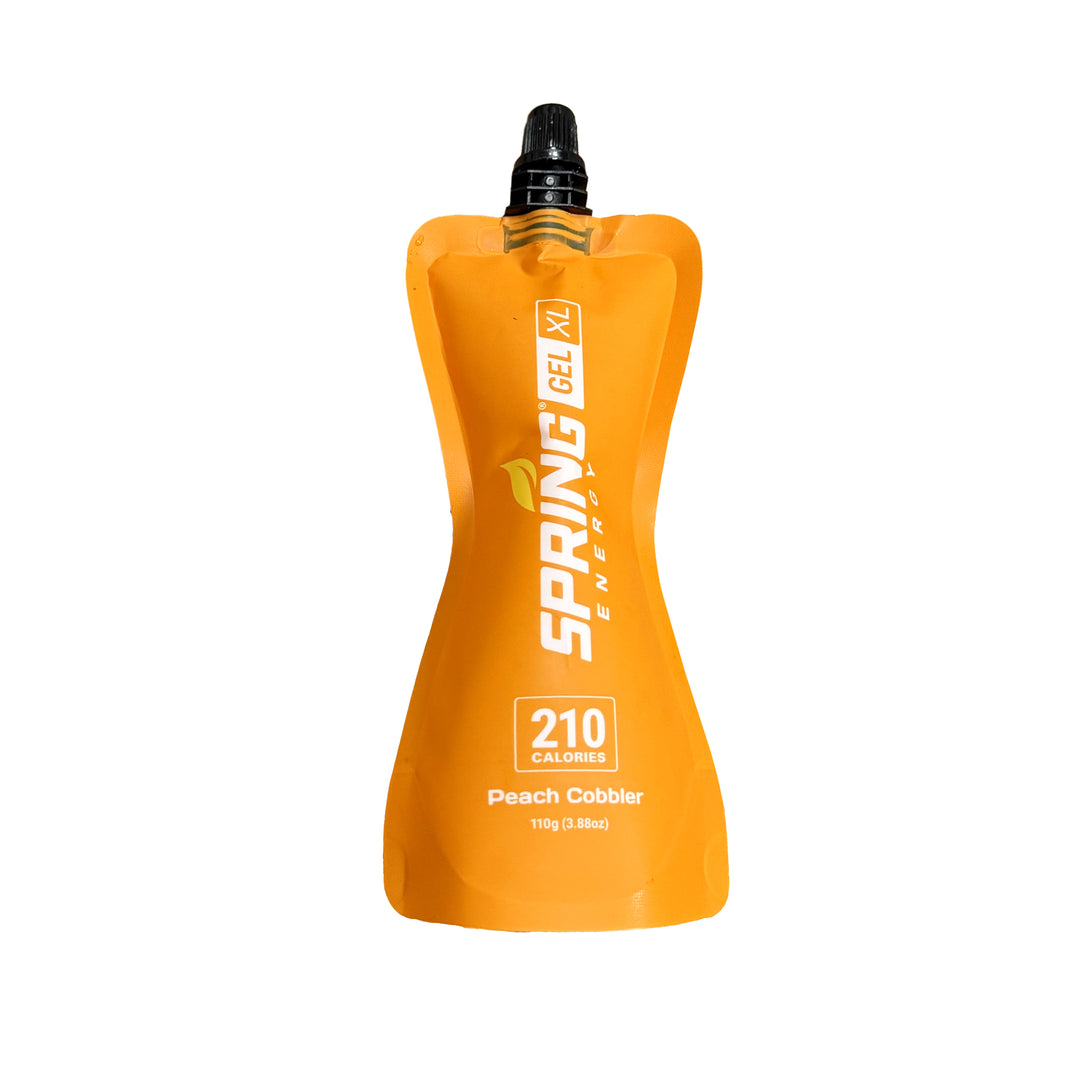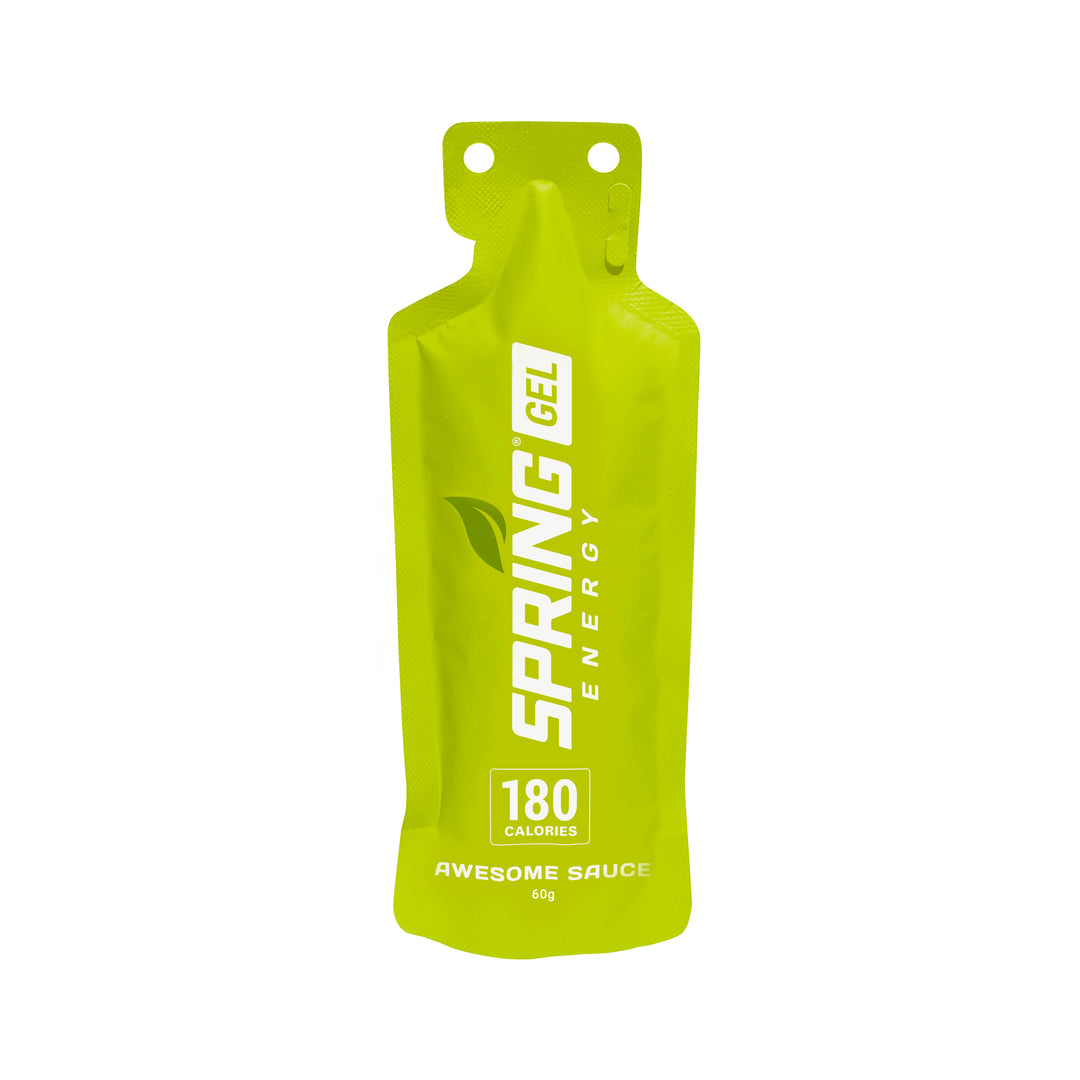Why Real Food Energy Gels Are the Most Efficient Way to Fuel Endurance Performance

Why Real Food Energy Gels Are the Most Efficient Way to Fuel Endurance Performance
By Rafal Nazarewicz, Ph.D. Nutrition
Keywords: real food energy gels, Spring Energy, endurance nutrition, glucose transporters, maltodextrin alternatives, sports nutrition science, metabolic efficiency, osmolarity
The Limitations of Traditional Energy Gels: A Metabolic Bottleneck
For decades, endurance athletes have relied on high-sugar, rice syrup, and maltodextrin-based energy gels as their primary fuel source during long training sessions and races. However, emerging research reveals significant limitations in this single-source carbohydrate approach that can actually impair performance rather than enhance it.
The Glucose Transporter Problem: SGLT1 and the 60g/Hour Ceiling
The human intestine has a finite capacity to absorb glucose and glucose polymers such as maltodextrin. This limitation stems from the sodium-glucose cotransporter 1 (SGLT1), which has a maximum absorption rate of approximately 60 grams of glucose per hour (Jeukendrup, 2014).
When athletes consume maltodextrin-only gels, they're essentially trying to push all their fuel through a single, narrow doorway. Once this transporter becomes saturated, additional glucose simply sits in the gut, leading to:
- Gastrointestinal distress
- Bloating and cramping
- Delayed gastric emptying
- Wasted calories that never reach working muscles
Research published in the Journal of Applied Physiology demonstrates that glucose ingestion rates exceeding 60g/hour provide no additional oxidation benefit when consumed alone (Jeukendrup & Jentjens, 2000). You're essentially hitting a metabolic ceiling.
The Osmolarity Crisis: Why High Sugar Concentrations Slow Absorption
Traditional energy gels present another critical problem: high osmolarity. Osmolarity refers to the concentration of dissolved particles in a solution. High-osmolarity solutions (>400 mOsmol/L) draw water INTO the intestinal lumen rather than facilitating absorption, a phenomenon that significantly delays gastric emptying and fluid delivery (Leiper, 2015).
Maltodextrin-based gels typically have osmolarity values of 300-500 mOsmol/L or higher. This creates a cascade of problems:
- Delayed gastric emptying - The stomach holds onto high-osmolarity contents longer
- Fluid secretion into the gut - Your body actually pulls water from circulation into the intestine to dilute the concentrated solution
- Dehydration risk - Paradoxically, these gels can contribute to dehydration during critical moments
A study in Medicine & Science in Sports & Exercise found that solutions with osmolarity above 300 mOsmol/L significantly reduced fluid absorption rates compared to lower osmolarity formulations (Shi et al., 2004).
The Real Food Solution: Multiple Transporters, Multiple Fuel Sources
Unlocking Additional Glucose Transporters with Other Carbohydrates
Here's where the science gets exciting. The intestine possesses multiple independent carbohydrate transporters. While SGLT1 handles glucose and maltodextrin, GLUT5 specifically transports fructose via a completely separate pathway (Shi et al., 2017).
By combining glucose sources with other carbs, athletes can achieve carbohydrate oxidation rates of 90 grams per hour or more - a 50% increase over glucose-only approaches (Currell & Jeukendrup, 2008). This isn't theoretical; it's been repeatedly demonstrated in metabolic chamber studies using isotope tracers.
The landmark study by Currell and Jeukendrup (2008), published in Medicine & Science in Sports & Exercise, showed that cyclists consuming a glucose-fructose blend improved time-trial performance by 8% compared with glucose-only feeding during prolonged exercise. This represents the difference between a podium finish and mid-pack placement.
The Power of Multiple Fuel Substrates: Fat, Protein, and Complex Carbohydrates
Real food energy gels that incorporate diverse macronutrients provide additional metabolic advantages that extend beyond simple carbohydrate absorption:
1. Fat Oxidation and Metabolic Flexibility
While high-intensity exercise relies primarily on carbohydrates, the presence of small amounts of fat in fuel sources promotes metabolic flexibility—the ability to seamlessly switch between fuel sources (Volek et al., 2016).
Research in Metabolism demonstrates that athletes who consume mixed macronutrient fuels maintain higher rates of fat oxidation during submaximal exercise, thereby sparing limited glycogen stores for high-intensity surges (Zajac et al., 2014). This is particularly crucial during ultra-endurance events where glycogen preservation determines success.
2. Protein's Role in Preventing Central Fatigue and Supporting Recovery
Small amounts of protein (even 2-4g per gel) provide branched-chain amino acids (BCAAs) that cross the blood-brain barrier and compete with tryptophan uptake, potentially delaying central fatigue (Meeusen et al., 2006).
Additionally, protein consumed during exercise provides amino acids for:
- Ongoing muscle protein synthesis
- Immune function support during prolonged stress
- Prevention of excessive muscle protein breakdown
A study in Medicine & Science in Sports & Exercise found that adding protein to carbohydrate feeding during endurance exercise reduced markers of muscle damage and improved subsequent recovery (Saunders et al., 2004).
3. Complex Carbohydrates and Sustained Energy Release
Real food sources contain starches and complex carbohydrates with varying glycemic indices. This diversity creates a more sustained glucose delivery profile rather than the spike-and-crash pattern of pure maltodextrin (Ludwig, 2002).
The presence of soluble fibers in real food (even in small amounts) also:
- Improves gastric emptying regulation
- Provides prebiotic support for the gut microbiome
- Enhances mineral absorption (particularly sodium and potassium)
Spring Energy: Real Food Engineering Meets Sports Science
Spring Energy gels exemplify the practical application of this research by utilizing real food ingredients like fruit purees, nut butters, and natural sweeteners that provide:
✓ Multiple carbohydrate sources - Activating both SGLT1 and GLUT5 transporters ✓ Lower osmolarity - Typically 200-280 mOsmol/L, facilitating faster absorption ✓ Balanced macronutrients - Small amounts of fat and protein supporting metabolic flexibility ✓ Natural electrolytes - From whole food sources like coconut and dates ✓ Reduced GI distress - Real food matrices are gentler on the digestive system
The Gut Microbiome Factor
An often-overlooked advantage of real food gels is their impact on the gut microbiome. Emerging research shows that the gut microbiome plays a crucial role in athletic performance, influencing everything from inflammation to immune function (Mach & Fuster-Botella, 2017).
Synthetic ingredients in traditional gels can negatively affect gut bacterial diversity (Suez et al., 2014), whereas whole-food ingredients provide prebiotics and polyphenols that support a healthy microbiome. During long races, this difference can manifest as reduced GI distress and better immune resilience.
Practical Application: How to Maximize Your Fueling Strategy
Based on the science, here's how endurance athletes should approach nutrition:
For Events Under 90 Minutes
- Glycogen stores are usually sufficient
- If fueling, use small amounts (30-40g carbs/hour)
- Real food gels provide sustained energy without GI upset
For Events 90 Minutes to 3 Hours
- Target 60-80g carbs/hour using multiple sources
- Alternate real food gels with fruits or other whole food options
- Monitor hydration separately
For Ultra-Endurance (3+ Hours)
- Aim for 80-90g carbs/hour from diverse sources
- Include real food gels with fat and protein
- Incorporate whole foods during lower-intensity periods
- Prioritize GI comfort over maximum carb intake
Your Gut Can't Be Fooled
The evidence is clear: single-source, high-glucose gels represent outdated nutritional science that ignores fundamental principles of human metabolism. The glucose transporter bottleneck, osmolarity limitations, and lack of metabolic flexibility all conspire to limit performance and increase GI distress.
Real food energy gels that incorporate multiple carbohydrate sources, balanced macronutrients, and lower osmolarity solutions work WITH your physiology rather than against it. They maximize absorption, support metabolic efficiency, and reduce the risk of the dreaded "bonk" or GI meltdown.
For athletes serious about performance, the choice is clear: fuel with real food, respect the science of absorption, and give your body the diverse nutrients it evolved to use efficiently.
References
Currell, K., & Jeukendrup, A. E. (2008). Superior endurance performance with ingestion of multiple transportable carbohydrates. Medicine & Science in Sports & Exercise, 40(2), 275-281.
Jeukendrup, A. E. (2014). A step towards personalized sports nutrition: carbohydrate intake during exercise. Sports Medicine, 44(1), 25-33.
Jeukendrup, A. E., & Jentjens, R. (2000). Oxidation of carbohydrate feedings during prolonged exercise: current thoughts, guidelines and directions for future research. Sports Medicine, 29(6), 407-424.
Leiper, J. B. (2015). Fate of ingested fluids: factors affecting gastric emptying and intestinal absorption of beverages in humans. Nutrition Reviews, 73(suppl 2), 57-72.
Ludwig, D. S. (2002). The glycemic index: physiological mechanisms relating to obesity, diabetes, and cardiovascular disease. JAMA, 287(18), 2414-2423.
Mach, N., & Fuster-Botella, D. (2017). Endurance exercise and gut microbiota: A review. Journal of Sport and Health Science, 6(2), 179-197.
Meeusen, R., Watson, P., Hasegawa, H., Roelands, B., & Piacentini, M. F. (2006). Central fatigue: the serotonin hypothesis and beyond. Sports Medicine, 36(10), 881-909.
Saunders, M. J., Kane, M. D., & Todd, M. K. (2004). Effects of a carbohydrate-protein beverage on cycling endurance and muscle damage. Medicine & Science in Sports & Exercise, 36(7), 1233-1238.
Shi, X., Horn, M. K., Osterberg, K. L., Stofan, J. R., Zachwieja, J. J., Horswill, C. A., ... & Murray, R. (2004). Gastrointestinal discomfort during intermittent high-intensity exercise: effect of carbohydrate-electrolyte beverage. International Journal of Sport Nutrition and Exercise Metabolism, 14(6), 673-683.
Shi, X., Passe, D. H., & Lambert, G. P. (2017). Carbohydrate-electrolyte beverages and exercise performance. Sports Science Exchange, 30(182), 1-6.
Suez, J., Korem, T., Zeevi, D., Zilberman-Schapira, G., Thaiss, C. A., Maza, O., ... & Elinav, E. (2014). Artificial sweeteners induce glucose intolerance by altering the gut microbiota. Nature, 514(7521), 181-186.
Volek, J. S., Noakes, T., & Phinney, S. D. (2016). Rethinking fat as a fuel for endurance exercise. European Journal of Sport Science, 15(1), 13-20.
Zajac, A., Poprzecki, S., Maszczyk, A., Czuba, M., Michalczyk, M., & Zydek, G. (2014). The effects of a ketogenic diet on exercise metabolism and physical performance in off-road cyclists. Nutrients, 6(7), 2493-2508.
This article is for educational purposes. Individual nutritional needs vary. Consult with a sports nutritionist or healthcare provider before making significant changes to your fueling strategy.







Leave a comment